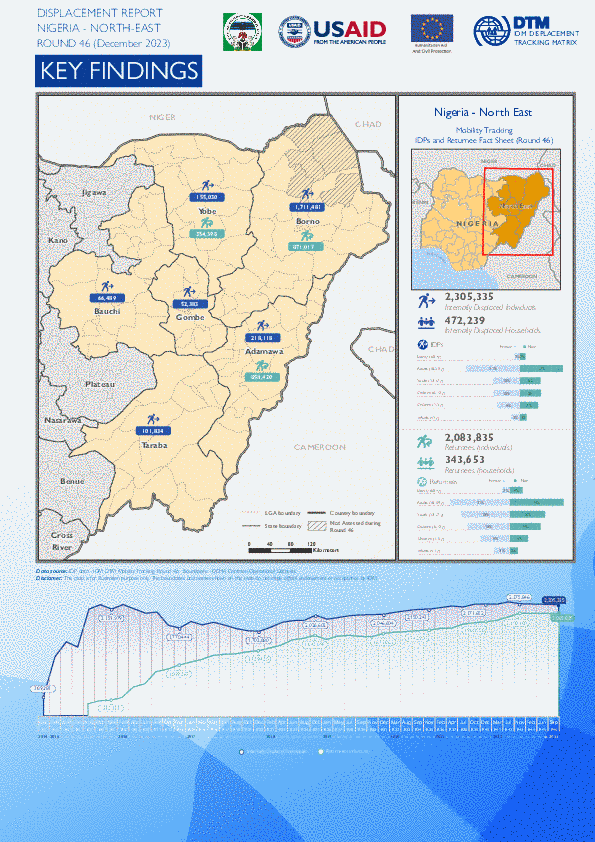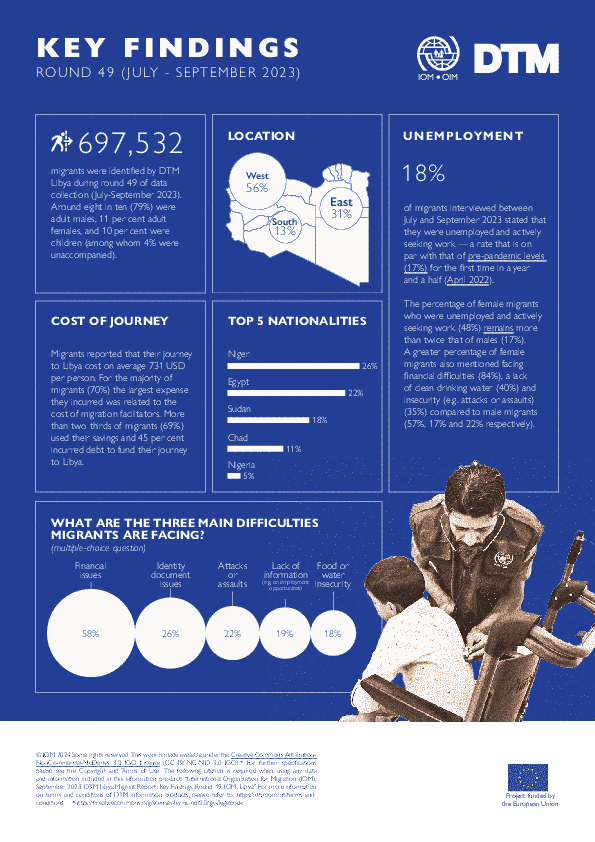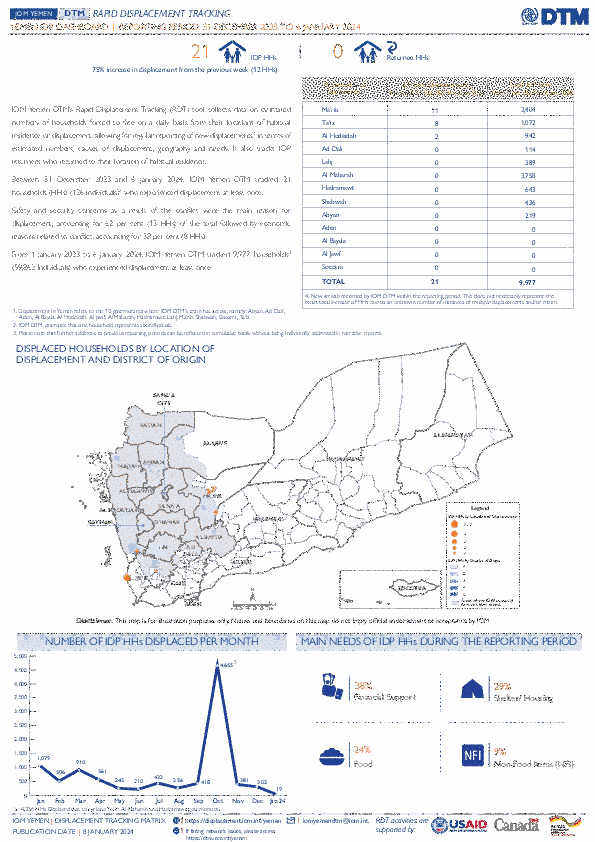-
Countries
-
Data and Analysis
-
Special Focus
-
Crisis Responses
Contact
dtmlibya@iom.int
Location
Libya
Activity
- Mobility Tracking
- Baseline Assessment
Period Covered
-Jul 01 2023
Population Groups
Migrants Present
Survey Methodology
Unit of Analysis Or Observation
Admin Area 3
Admin Area 4
Type of Survey or Assessment
Keywords
Geographical Scope
Administrative boundaries with available data
The current dataset covers the following administrative boundaries

Contact
DTM Libya, DTMLibya@iom.int
Language
English
Location
Libya
Period Covered
Jul 01 2023
Sep 30 2023
Activity
- Mobility Tracking
- Baseline Assessment
IOM Libya’s Displacement Tracking Matrix (DTM) programme identified a total of 697,532 migrants from over 45 nationalities in the 100 Libyan municipalities during round 49 of data collection (July - September 2023). The number of migrants in Libya has continued to decrease slightly compared to the previous round of data collection (from 704,369 migrants, round 48 to 697,532 migrants, round 49) in line with a trend that started at the beginning of 2023 when there were 706,472 migrants (round 46, January - February 2023).

Contact
DTM Nigeria, iomnigeriadtm@iom.int
Language
English
Location
Nigeria
Period Covered
Jul 17 2023
Sep 30 2023
Activity
- Mobility Tracking
- Baseline Assessment
Data collection for IDPs took place between July and September 2023 in 2,068 localities in the six states of north-east Nigeria (Borno, Adamawa, Yobe, Gombe, Taraba and Bauchi). Data collection for returnees took place during the same assessment period in the BAY states of north-east Nigeria (Borno, Adamawa and Yobe).
The DTM identified a total of 2,305,335 IDPs in 472,239 households and 2,083,835 returnees in 343,653 households. The IDP population included IDPs in camps and camp-like settings (929,453 individuals or 40%) and IDPs residing in host communities (1,375,882 individuals or 60%). The returnee population included IDP returnees (1,874,283 individuals or 90%) and returnees from abroad (209,552 individuals or 10%).

Contact
DTM Libya, DTMLibya@iom.int
Language
English
Location
Libya
Snapshot Date
Sep 30 2023
Activity
- Flow Monitoring
- Mobility Tracking
- Baseline Assessment
This infographic presents the key findings of Round 49 of the mobility tracking and flow monitoring components of the Displacement Tracking Matrix (DTM) programme in Libya.

Contact
dtmhaiti@iom.int
Language
English
Location
Haiti
Period Covered
Jan 02 2024
Jan 08 2024
Activity
- Mobility Tracking
- Event Tracking
On 2 January 2024, an armed attack took place in the municipalty of Croix-Des-Bouquets, affecting several neighborhoods such as Guedon and Turbe, located in the 4th communal section of Petit Bois, as well as the neighborhoods of Galette – Roche Blanche and Denis – Campeche Livia in the 3rd communal section of Petit Bois.
As a result of these events, approximately 67 households, comprising 268 individuals, were forced to flee their homes towards areas within the same municipality, as well as in Tabarre and Delmas. All these displaced individuals have found refuge with host families.

Contact
DTM Sudan; dtmsudan@iom.int
Language
English
Location
Sudan
Period Covered
Dec 28 2023
Jan 03 2024
Activity
- Mobility Tracking
- Baseline Assessment
Overview
From 15 April 2023, armed clashes erupted between the Sudanese Armed Forces (SAF) and the Rapid Support Forces (RSF) in multiple cities across Sudan. Clashes initially took place in cities across Northern and Khartoum states, later spreading across the Darfur and Kordofan regions.
Highlights
- DTM Sudan estimates that 6,036,176 individuals (1,201,356 Households) were recently internally displaced.
- The IDP caseload was observed in 6,282 locations across all of Sudan’s 18 states.
- The highest proportions of IDPs were observed across South Darfur (12%), East Darfur (11%), River Nile (11%), Aj Jazirah (8%), White Nile (8%), and North Darfur (8%).
- Field teams reported that the IDPs observed were originally displaced from twelve states. The majority (3,681,297, 61%) were reportedly displaced from Khartoum state; followed by South Darfur (15%), North Darfur (8%), Aj Jazirah (5%), Central Darfur (4%), West Darfur (3%), East Darfur (1%), South Kordofan (1%), North Kordofan (1%), West Kordofan (<1%), Sennar (<1%), and White Nile (<1%).
- IOM-DTM also reported that an estimated 1,574,135 mixed cross-border movements were made into neighbouring countries.
- This product provides brief insights into those displaced in Sudan post-15 April 2023. For more granular information on the IDP caseload and the displacement context, please see IOM-DTM's Monthly Displacement Overview (04).

Contact
DTMMozambique@iom.int
Language
English
Location
Mozambique
Period Covered
Dec 27 2023
Jan 08 2024
Activity
- Mobility Tracking
- Event Tracking
Between 26 December 2023 and 8 January 2024, a series of attacks in villages across Macomia, and Muidumbe triggered 1,811 individual displacements. Of the total 304 individuals displaced, 89 families with 293 individuals have taken refuge in displacement centers of Mueda (Lyanda, Mpeme and Eduardo Mondlane), 113 families with 397 individuals have taken refuge in displacement centers of Macomia (Nanga A and Nanga B) and 6 families with 31 individuals have taken refuge in displacement centers of Muidumbe (Matambalale and Lutete).

Contact
iomyemendtm@iom.int
Language
English
Location
Yemen
Period Covered
Dec 31 2023
Jan 06 2024
Activity
- Mobility Tracking
- Event Tracking
IOM Yemen DTM’s Rapid Displacement Tracking (RDT) tool collects data on estimated numbers of households forced to flee on a daily basis from their locations of origin or displacement, allowing for regular reporting of new displacements in terms of estimated numbers, geography, and needs. It also tracks returnees who returned to their location of origin.
From 1 January 2023 to 6 January 2024, IOM Yemen DTM tracked 9,977 households (HH) (59,862 Individuals) who experienced displacement at least once.
Between 31 December 2023 and 6 January 2024, IOM Yemen DTM tracked 21 households (126 individuals) displaced at least once. The majority of people moved into/within the following governorates and districts:
- Ma’rib (11 HHs) – Marib (5 HHs), Marib City (4 HHs), Harib (2 HHs) districts. Most displacements in the governorate originated from Marib and Al Hodeidah.
- Ta’iz (8 HHs) – Al Makha (7 HHs) district, Al Misrakh (1 HH). Most displacements in the governorate originated from Taiz and Al Hodeidah.
- Al Hodeidah (2 HHs) – Hays (2 HHs) district. All displacements in the governorate were internal.
The majority of people moved from the following governorates and districts:
- Al Hodeidah (8 HHs) – Hays (4 HHs), Al Jarrahi (2 HHs), Al Marawiah (1 HHs) districts.
- Ta’iz (4 HHs) – Al Misrakh (4 HHs) district.
- Ma’rib (4 HHs) – Jabal Murad (2 HHs), Al Jubah (1 HHs), Harib (1 HHs) districts.
IOM identified 28 households displaced in the previous reporting period, which covered 24 - 30 December 2023, in the governorates of Al Hodeidah (18 HHs) and Ma’rib (10 HHs). These figures have been added to the cumulative displacement total recorded since the beginning of the year.
Contact
DTM Yemen, iomyemendtm@iom.int
Location
Yemen
Activity
- Mobility Tracking
- Event Tracking
Period Covered
Dec 31 2023 -Jan 06 2024
From 1 January to 6 January 2024, IOM Yemen DTM tracked 9,977 households (HH) (59,862 Individuals) who experienced displacement at least once.
Between 31 December 2023 and 6 January 2024, IOM Yemen DTM tracked 21 households (126 individuals) displaced at least once. The majority of people moved into/within the following governorates and districts:
- Ma’rib (11 HHs) – Marib (5 HHs), Marib City (4 HHs), Harib (2 HHs) districts. Most displacements in the governorate originated from Marib and Al Hodeidah.
- Ta’iz (8 HHs) – Al Makha (7 HHs) district, Al Misrakh (1 HH). Most displacements in the governorate originated from Taiz and Al Hodeidah.
- Al Hodeidah (2 HHs) – Hays (2 HHs) district. All displacements in the governorate were internal.
The majority of people moved from the following governorates and districts:
- Al Hodeidah (8 HHs) – Hays (4 HHs), Al Jarrahi (2 HHs), Al Marawiah (1 HHs) districts.
- Ta’iz (4 HHs) – Al Misrakh (4 HHs) district.
- Ma’rib (4 HHs) – Jabal Murad (2 HHs), Al Jubah (1 HHs), Harib (1 HHs) districts.
Population Groups
Survey Methodology
Unit of Analysis Or Observation
Type of Survey or Assessment
Keywords
Geographical Scope
Administrative boundaries with available data
The current dataset covers the following administrative boundaries
Contact
iomyemendtm@iom.int
Location
Yemen
Activity
- Flow Monitoring Survey
- Flow Monitoring
Period Covered
Dec 01 2023 -Dec 31 2023
In December 2023, IOM Yemen DTM recorded 1,679 migrants entering Yemen, an increase of 13 per cent compared to last month (1,465). Shabwah typically serves as an entry point for migrants from Somalia and rarely sees migrants departing from Djibouti due to the considerable distance between Djibouti and Shabwah. In Shabwah, the total number of migrants entered during December was 1,569 (1,197 departing from Somalia and 372 departing from Djibouti).
The overall number of migrants entering through Shabwah has increased by seven per cent in December (1,569) compared to November (1,465). According to DTM, conflict-induced movements constituted 73 per cent of all incoming movements in December 2023. These movements were exclusively observed in Shabwah, originating from Bari, Somalia (70%) and Obock, Djibouti (30%).
Djibouti DTM team recorded 286 migrants (272 males and 14 females) returned to the Horn of Africa during December 2023 due to the humanitarian crisis in Yemen and challenges in reaching Saudi Arabia. Additionally, DTM observed a decrease in Yemeni returnees by six per cent in December (4,827) compared to November (5,111). Between January and December 2023, DTM recorded a total of 97,210 migrants and 55,402 Yemeni migrant returnees to Yemen.
Population Groups
Survey Methodology
Unit of Analysis Or Observation
Type of Survey or Assessment
Keywords
Geographical Scope
Administrative boundaries with available data
The current dataset covers the following administrative boundaries
